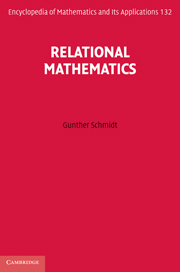Book contents
- Frontmatter
- Contents
- Notes on illustrations
- Preface
- 1 Introduction
- PART I REPRESENTATIONS OF RELATIONS
- 2 Sets, subsets, and elements
- 3 Relations
- PART II OPERATIONS AND CONSTRUCTIONS
- PART III ALGEBRA
- PART IV APPLICATIONS
- PART V ADVANCED TOPICS
- Appendix A Notation
- Appendix B Proofs postponed from Part II
- Appendix C Algebraic visualization
- Appendix D Historical annotations
- References
- Symbols
- Index
2 - Sets, subsets, and elements
from PART I - REPRESENTATIONS OF RELATIONS
Published online by Cambridge University Press: 05 May 2013
- Frontmatter
- Contents
- Notes on illustrations
- Preface
- 1 Introduction
- PART I REPRESENTATIONS OF RELATIONS
- 2 Sets, subsets, and elements
- 3 Relations
- PART II OPERATIONS AND CONSTRUCTIONS
- PART III ALGEBRA
- PART IV APPLICATIONS
- PART V ADVANCED TOPICS
- Appendix A Notation
- Appendix B Proofs postponed from Part II
- Appendix C Algebraic visualization
- Appendix D Historical annotations
- References
- Symbols
- Index
Summary
Usually, we are confronted with sets at a very early period of our education. Depending on the respective nationality, it is approximately at the age of 10 or 11 years. Thus we carry with us quite a burden of concepts concerning sets. At least in Germany, Mengenlehre as taught in elementary schools will raise bad memories on discussing it with parents of school children. All too often, one will be reminded of Georg Cantor, the inventor of set theory, who became mentally ill. At a more advanced level, we encounter a number of paradoxes making set theory problematic, when treated in a naïve way. One has to avoid colloquial formulations completely and should confine oneself to an adequately restricted formal treatment.
The situation does not improve when addressing logicians. Most of them think in just one universe of discourse containing numbers, letters, pairs of numbers, etc., altogether rendering themselves susceptible to numerous semantic problems. While these, in principle, can be overcome, ideally they should nevertheless be avoided from the beginning.
In our work with relations, we will mostly be restricted to finite situations, which are much easier to work with and to which most practical work is necessarily confined. A basic decision for this text is that a (finite) set is always introduced together with a linear ordering of its elements. Only then we will have a well-defined way of presenting a relation as a Boolean matrix.
- Type
- Chapter
- Information
- Relational Mathematics , pp. 5 - 14Publisher: Cambridge University PressPrint publication year: 2010

